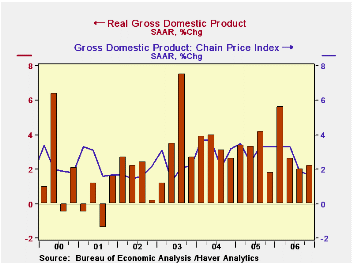 Global| Feb 28 2007
Global| Feb 28 2007US 4Q GDP Revised Down to 2.2% Growth, in Line with Forecasts
Summary
U.S. real GDP grew 2.2% (AR) last quarter, revised from the unexpectedly large 3.5% reported last month. After release of December construction, trade and inventory data, market forecasters estimated the change to GDP fairly well in [...]

U.S. real GDP grew 2.2% (AR) last quarter, revised from the unexpectedly large 3.5% reported last month. After release of December construction, trade and inventory data, market forecasters estimated the change to GDP fairly well in line with what the BEA reported this morning. The reduction in Q4 lowered growth for the entirety of 2006 by 0.1% to 3.3%.
The largest difference between the Advance and Preliminary reports came in inventories. Initially reported with a $20.1 billion liquidation in real terms, they were chopped $18.0 billion more in this revision; the total $38.1 billion inventory liquidation took away 1.4% from total growth versus 0.7% in last month's report.
The contribution from net exports was reduced from 1.6 percentage points to 1.5 points as a sizable upward revision to exports of services (13.0% gain to 15.5%) was more than offset by the effect of a smaller contraction in imports, 2.2% versus 3.2% estimated before. This was still the largest contribution from net exports since Q4 1996. Final sales to domestic purchasers were reduced from the Advance estimate of 2.4% growth to 2.0%. Personal consumption expenditures grew 4.2%, a bit lower than the 4.4% reported before; both durable and nondurable goods had slower growth than the initial report, but consumption of services was revised modestly higher. Residential investment was marginally less weak than the previous estimate, now showing a 19.1% decrease compared with 19.2% before.
Final sales to domestic purchasers were reduced from the Advance estimate of 2.4% growth to 2.0%. Personal consumption expenditures grew 4.2%, a bit lower than the 4.4% reported before; both durable and nondurable goods had slower growth than the initial report, but consumption of services was revised modestly higher. Residential investment was marginally less weak than the previous estimate, now showing a 19.1% decrease compared with 19.2% before.
Nonresidential fixed investment fell 2.4%, revised from 0.4%, after a 10.0% gain the prior quarter. Outlays for structures were slashed from 2.8% growth to an 0.8% rate of decline. Equipment spending also saw a sizable downward shift from -1.8% to -3.2% in the Q4 estimate, following 7.7% in Q3.
The GDP chain price index was lifted slightly to a 1.7% gain from 1.5%; despite the increase, this remains the weakest quarterly advance since early 2003. The overall PCE chain price index was lowered from -0.8% to -0.9%. This was the first outright quarterly decline in PCE prices since 1961. The "core" PCE chain price index less food and energy rose 1.9%, a modest downward revision, as well, from the advance report of 2.1% and from 2.2% in Q3.
| Chained 2000$, % AR | 4Q '06 | 4Q '06 | 3Q '06 | Y/Y | 2006 | 2005 | 2004 |
|---|---|---|---|---|---|---|---|
| GDP | 2.2% | 3.5% | 2.0% | 3.1% | 3.3% | 3.2% | 3.9% |
| Inventory Effect | -1.4% | -0.7% | 0.1% | -0.2% | 0.2% | -0.3% | 0.4% |
| Final Sales | 3.6% | 4.2% | 1.9% | 3.3% | 3.1% | 3.5% | 3.5% |
| Foreign Trade Effect | 1.5% | 1.6% | -0.2% | 0.6% | 0.0% | -0.1% | -0.5% |
| Domestic Final Demand | 2.1% | 2.4% | 2.0% | 2.7% | 3.1% | 3.6% | 4.0% |
| Chained GDP Price Index | 1.7% | 1.5% | 1.9% | 2.5% | 2.9% | 3.0% | 2.8% |
Carol Stone, CBE
AuthorMore in Author Profile »Carol Stone, CBE came to Haver Analytics in 2003 following more than 35 years as a financial market economist at major Wall Street financial institutions, most especially Merrill Lynch and Nomura Securities. She has broad experience in analysis and forecasting of flow-of-funds accounts, the federal budget and Federal Reserve operations. At Nomura Securites, among other duties, she developed various indicator forecasting tools and edited a daily global publication produced in London and New York for readers in Tokyo. At Haver Analytics, Carol is a member of the Research Department, aiding database managers with research and documentation efforts, as well as posting commentary on select economic reports. In addition, she conducts Ways-of-the-World, a blog on economic issues for an Episcopal-Church-affiliated website, The Geranium Farm. During her career, Carol served as an officer of the Money Marketeers and the Downtown Economists Club. She has a PhD from NYU's Stern School of Business. She lives in Brooklyn, New York, and has a weekend home on Long Island.





